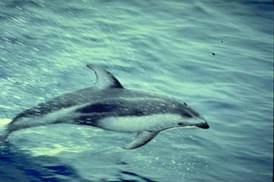
NOAA Photo / B. Hacker Lagenorhynchus obliquidensBasic FactsWhite-sided dolphins are gregarious, often found in groups of up to several thousand individuals. They seem to enjoy an encounter with a boat and seek out and travel with other species of dolphins, and even baleen whales. Among marine biologists, they are commonly called “lags” (a shortening of their genus). A group of lags can be observed from a great distance as what looks like a boiling of the ocean water. This is caused by their frequent, almost unceasing show of acrobatics. These dolphins swim fast and regularly leave the water in pairs and trios. The Pacific whitesided dolphin is the only dolphin of the eastern Pacific known to turn complete somersaults under natural conditions. Lags are conically shaped, toothed marine mammals with a prominent melon, a short black beak, and a robust body. They have a black back with white side stripes, called “suspenders,” stretching from their forehead along their ribs to their anus, and light gray from forehead along the sides. They also have a white belly and a tall twotoned dorsal fin that is curved and resembles a hook. An average adult is seven and a half feet long and weighs 300 pounds. Habitat, Range and Local SightingsMost reported sightings of these dolphins come from temperate, offshore waters in the north Pacific. They are believed to move close to the Southern California shore in the winter and spring, and then move north and farther out to sea in the summer and fall with excursions inshore following runs of prey. Until recent years they were rarely seen close to shore in our area, but then began appearing more and more. During the 2003 summer season, they were seen often enough that it caused great disappointment when they could not be found. In 2006 and 2007, these sightings again became rare. When spotted, the animals are almost always located at the edge of open water on a line between Barwell Island and No Name Island. Food and Survival StrategiesPacific white-sided dolphins feed in large groups on a variety of small schooling fish such as herring, anchovy, capelin, sandlance, hake, and also squid. A pod will often coordinate and circle a school of fish to trap them and then feed extensively. Lags swim in large groups and will often care for a sick or injured member of their group. Transient orcas are the top predator. A study in British Columbia correlated the presence of the dolphins with capelin that had also recently come to the area. It is possible that subtle changes in the Kenai Fjords ecosystem are bringing Pacific white-sided dolphins into the area. Reproduction and YoungPacific white-sided dolphins may breed and calve in the spring and summer. After a 10- to 12-month gestation period, a three foot calf is born. A female can reproduce as often as every two years, but most give birth once every three years. This species of dolphin may live to 45 years. Human ConnectionsThey are still harvested off the coast of Japan, but are at a lower level of commercial harvest than other marine mammals hunted there. Accidental deaths occur when these animals get caught up in fishing nets. |
Last updated: March 15, 2018
